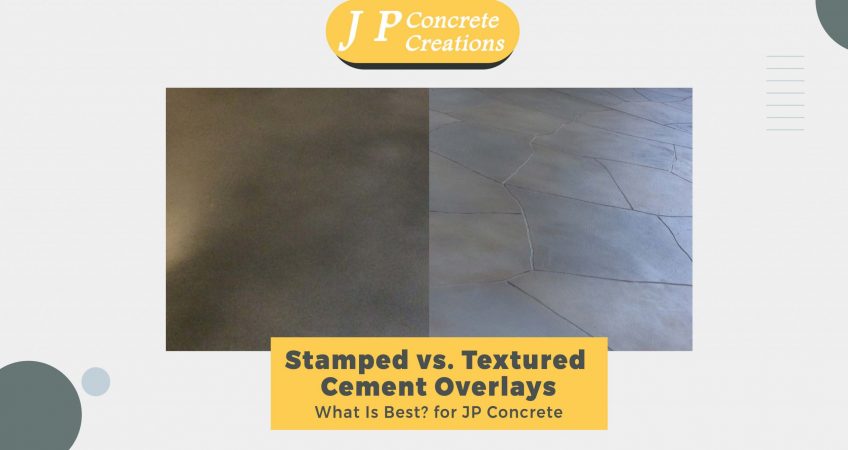Do you struggle to decide between a stamped overlay and concrete stamping? Property owners often have difficulty because of the growing variety of decorative concrete options. In this article, we’ll examine the variations between stamped concrete and textured cement overlays and help you choose the best solution for your requirements.
When it comes to concrete surfaces, durability is a key factor. After all, we expect them to last for many years without frequent repairs or replacements. While longevity is generally a positive attribute, it can also have drawbacks. One of them is the potential limitation of design and texture options. Being stuck with a design or texture that doesn’t please you can be frustrating. In this case, the long-lasting nature of concrete can become a double-edged sword.
Why People Frequently Choose Stamped Overlays
A stamped overlay uses molds to create patterns on concrete, while a textured overlay is created manually by skilled professionals using tools like trowels.
Craft craftsmen can use techniques like broom finishes, swirl patterns, slate patterns or rock textures to texture concrete. They can achieve various designs and finishes by adjusting the trowel’s angle, size, type, and swipe pattern. Your local professional might even be able to create a unique custom finish just for you.
Stamped concrete interior, also known as imprinted overlays or stamped toppings, are a fantastic way to transform plain concrete surfaces into the look of natural materials like stone, rock, brick, or wood.
A stamped overlay is a thin layer of cement material modified with polymers, typically between 3/8″ to 3/4″ thick. Its purpose is to resurface the existing substrate and provide a fresh, revitalized appearance.
These overlays are intended to hide ugly concrete surfaces that may be damaged, drab, or worn out. The overlay material can be stamped, embossed, or imprinted with different patterns after it has briefly set. These patterns frequently imitate the patterns and textures of stone, pebbles, slate, or tile. For more visual appeal, stampable overlays might be dyed or given a general color.
Which Overlay to Choose? : What Concrete Resurfacing Atlanta Experts Say
Textured toppings or stamped overlays are fantastic options to enhance your existing concrete without the hassle and cost of removing and replacing it. They offer a wide range of creative possibilities to add flair to your project while saving time and labor during installation.
But the Stamped Overlays have an edge to this here. Let’s see how!
Stamped overlays are particularly useful when nearby structures, such as staircases, swimming pools, or walls, could be at risk of damage during demolition. If your concrete is still in good condition and can be restored, opting for stamped overlays is highly recommended. It’s a practical and cost-effective way to give your concrete a fresh and appealing look.
By stamping an overlay, you can generate distinctive patterns that go with your surroundings and enhance the beauty of the place. You may create the appearance of brick, cobblestone, and many other designs using stamping patterns, all for a fraction of the price. Stamped concrete Georgia is very resilient, which makes stamped overlays an excellent alternative to other masonry materials.
A minimum of 3/8 inch of concrete must be applied to achieve a stamped overlay. Depending on how deep you want the pattern to be, you may need to apply more concrete to ensure a proper impression from the stamp.
FAQ-
1. What is a textured overlay in a stamped concrete interior?
A textured overlay is a surface treatment applied to concrete to create a desired texture or finish. It involves using specialized techniques, tools, and materials to add depth, pattern, or a tactile quality to the concrete surface.
2. What is textured overlay concrete ?
Textured overlay concrete refers to the specific application of a textured overlay onto a concrete surface. It involves applying a material layer, such as a polymer-modified cement topping, and using various methods to create texture and visual interest. This can include techniques like troweling, stamping, or using specialized tools to achieve the desired texture.
3. What is the difference between stamped overlay and textured overlay?
The main difference between a stamped and textured overlay is the application method and the final result. A stamped overlay uses pre-formed moulds or stamps to imprint specific patterns onto the concrete surface, mimicking the look of natural materials like stone, brick, or wood. On the other hand, a textured overlay involves using tools, such as trowels or brushes, to create texture directly on the surface without necessarily replicating specific patterns or imitating other materials.
4. What is overlayment flooring?
Overlayment flooring refers to a type of flooring system that involves applying a thin layer of material, typically a specialized overlay or topping, over an existing floor surface. The purpose of overlayment flooring is to enhance the current floor’s appearance, durability, or functionality. This can be achieved through various materials, such as polymer-based overlays, epoxy coatings, or decorative concrete toppings. Overlayment flooring is commonly used for renovations or to update the look of worn-out or outdated floors without the need for complete replacement.

